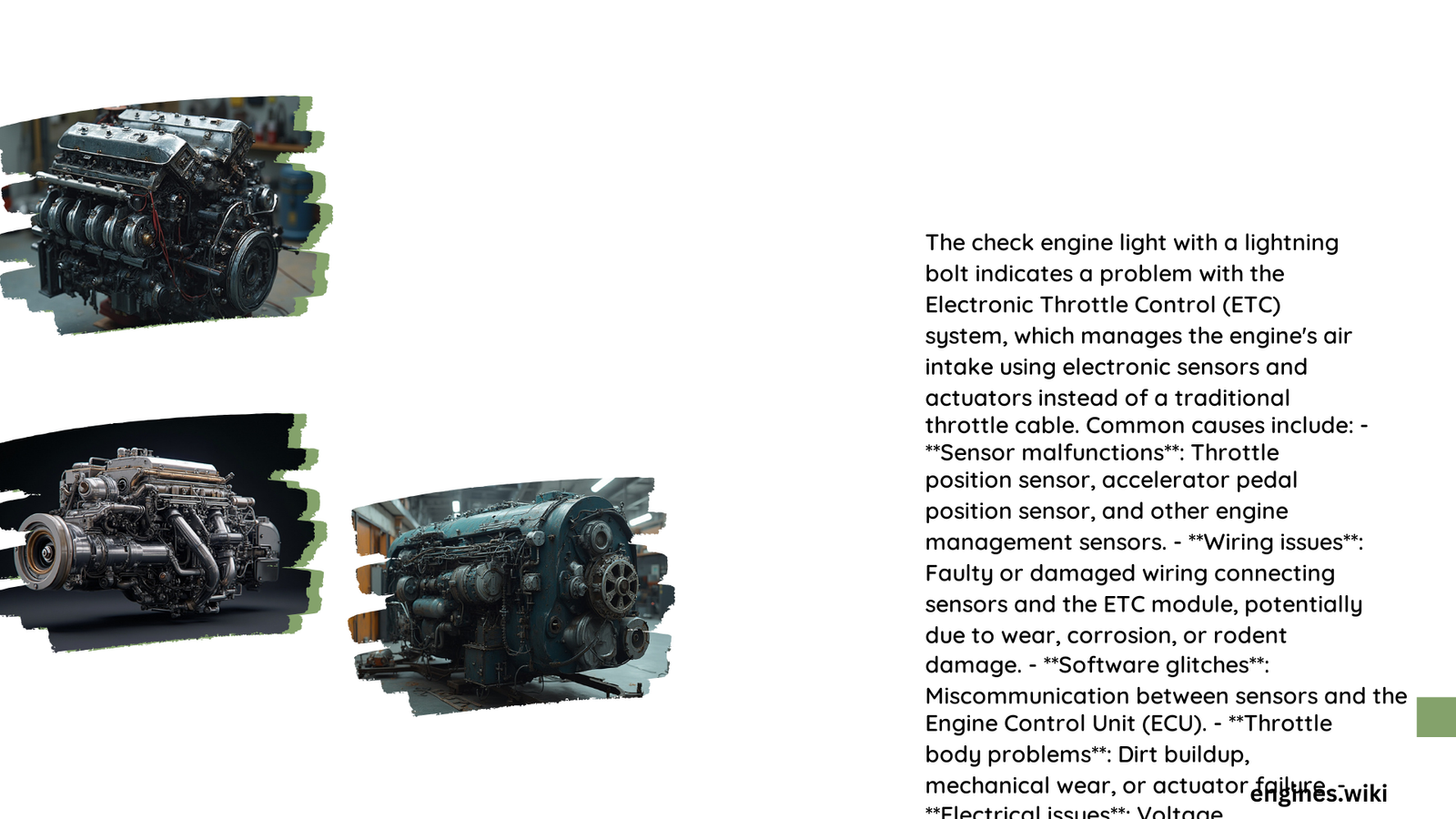The check engine light with a lightning bolt symbol, also known as the Electronic Throttle Control (ETC) warning light, indicates a problem with the vehicle’s electronic throttle control system. This system manages the throttle opening using electronic sensors and actuators instead of a traditional throttle cable. When this light appears, it signifies issues specifically related to the ETC system, which can affect engine performance, acceleration, and overall drivability.
What Does the Check Engine Light with Lightning Bolt Mean?
The check engine light with a lightning bolt symbol specifically indicates a problem with the Electronic Throttle Control (ETC) system. This system is responsible for managing the throttle opening electronically, replacing the traditional mechanical throttle cable. When this warning light illuminates, it suggests that the vehicle’s computer has detected an issue within the ETC system that requires attention.
Common Causes:
- Faulty Throttle Position Sensor
- Malfunctioning Accelerator Pedal Position Sensor
- Throttle Body Issues
- Electrical Problems
- Software Glitches in the Engine Control Unit (ECU)
What Are the Symptoms Associated with This Warning Light?

When the check engine light with a lightning bolt appears, you may experience various symptoms related to the ETC system malfunction:
- Irregular acceleration
- Engine hesitation or stumbling
- Reduced engine power
- Inconsistent throttle response
- Engine stalling
- Activation of ‘limp mode’
These symptoms can significantly affect your vehicle’s performance and potentially create unsafe driving conditions.
How to Diagnose the Problem?
To diagnose the issue causing the check engine light with lightning bolt to illuminate, follow these steps:
- Check for additional warning lights on the dashboard
- Restart the vehicle to see if the light clears
- Inspect wiring and connectors for signs of damage or corrosion
- Use a diagnostic scan tool to retrieve trouble codes
- Perform visual and mechanical inspections of the throttle body and related sensors
Diagnostic Trouble Codes
Common trouble codes associated with the ETC system include:
| Code | Description |
|---|---|
| P2135 | Throttle/Pedal Position Sensor Circuit Range/Performance Problem |
| P2101 | Throttle Actuator Control System Range/Performance Problem |
What Are the Repair Options and Costs?
Repair options and costs can vary depending on the specific issue causing the ETC warning light. Here are some common repairs and their estimated costs:
- Throttle Position Sensor Replacement
-
Cost: $200 – $500 (including labor)
-
Throttle Body Replacement
-
Cost: $300 – $700 (including labor)
-
Accelerator Pedal Position Sensor Replacement
-
Cost: $150 – $300 (including labor)
-
Wiring Repairs
-
Cost: Varies depending on the extent of damage
-
ECU Software Update
- Cost: $50 – $200 (depending on the dealership)
Labor rates typically range from $75 to $150 per hour, depending on the location and the mechanic’s experience.
Can I Drive with the Check Engine Light and Lightning Bolt On?
While it may be possible to drive short distances with the check engine light and lightning bolt illuminated, it’s not recommended for several reasons:
-
Reduced Performance: The ETC system malfunction can significantly impact your vehicle’s performance, making it unsafe to drive in normal traffic conditions.
-
Risk of Further Damage: Continuing to drive with a known issue can lead to more severe damage to your vehicle’s engine or other components.
-
Safety Concerns: Unpredictable acceleration or power loss can create dangerous situations on the road.
-
Potential for Complete Failure: In some cases, the ETC system may fail completely, leaving you stranded.
It’s best to have your vehicle diagnosed and repaired as soon as possible when you see this warning light.
How to Prevent ETC System Issues?
To help prevent issues with your vehicle’s Electronic Throttle Control system:
- Regular Maintenance: Follow your vehicle’s recommended maintenance schedule.
- Keep the Throttle Body Clean: Have it cleaned during routine service appointments.
- Address Warning Lights Promptly: Don’t ignore any dashboard warning lights.
- Quality Parts: Use high-quality replacement parts when repairs are needed.
- Avoid Extreme Conditions: Minimize exposure to harsh environments that can damage electrical components.
By following these preventive measures, you can help ensure the longevity and proper function of your vehicle’s ETC system.
What Tools Are Needed for Diagnosis and Repair?
For proper diagnosis and repair of ETC system issues, the following tools are typically required:
- Diagnostic Scan Tool: Essential for reading trouble codes and accessing live data from the vehicle’s computer.
- Multimeter: Used to test electrical connections and components.
- Throttle Body Cleaning Kit: For cleaning the throttle body if necessary.
- Basic Hand Tools: Screwdrivers, socket set, and wrenches for component removal and replacement.
- Specialized Tools: Some vehicles may require manufacturer-specific tools for certain repairs.
Professional mechanics will have access to more advanced diagnostic equipment, which can provide more detailed information about the ETC system’s performance.
Remember, while some diagnostic steps can be performed at home, complex ETC system repairs often require professional expertise and specialized equipment. If you’re unsure about any aspect of the diagnosis or repair process, it’s best to consult with a qualified mechanic.
References:
1. YouTube – The Red Lightning Bolt on Your Car’s Dashboard
2. CoPilot Search – What Does The Lightning Bolt Mean On A Car?
3. Michanic – Red Lightning Bolt Symbol On My Jeep Dashboard
